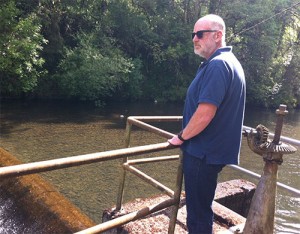
Silverton City Manager Bob Willoughby doesn’t want residents to panic or be worried.
Instead, he just wants to raise their awareness of the city’s water situation.
That’s why he asked the Silverton City Council at its special meeting on June 22 to vote to activate Stage 1 of Voluntary Water Curtailment. The council was unanimous in its support.
The voluntary curtailment, Willoughby said, is to take precautions.
He said activating voluntary water curtailment is a way to “start talking about and thinking about how we use water.”
Willoughby said the June water levels in the Silver and Abiqua creeks were what are normally seen at the end of July or early August. He added said the city’s water system is not dependent on snow melt, but rather rainfall.
Silverton Public Works Director Paul Eckley outlined the city’s current situation to the council. There are three stages in the city’s water curtailment plan. Stage One is voluntary conservation and curtailment; Stage Two is enhanced voluntary conversation and curtailment and Stage Three is mandatory restrictions.
City Councilor Kyle Palmer said Silverton residents are aware there is a water shortage.
“It hasn’t rained forever,” he said. “We are going to Stage One so we can hopefully avoid going to Stage Two,” he said.
Each stage is defined by the causes, severity and anticipated duration of the water shortage.
In Stage One, residents are encouraged to conserve water by:
Watering on even and odd days. For example, if your house number is 513, water on odd days of the month, 1, 3, 5…. If your house number is even, you water on even days, 2, 4, 6, etc.
Water at dawn or dusk or early morning and late evening to avoid loss through evaporation.
Make sure when watering the lawn the water is hitting the lawn and not the sidewalk.
Check for leaks around the house and outside water faucets.
Think of ways to conserve water – shorter showers, using gray water for watering, ete.
Other ideas to conserve water include having your car washed at a car wash that recycles the water and getting a spray noozle with a cut off for the garden hose. Ways to conserve water can be found at the city’s website, www.silverton.or.us
Councilor Dana Smith pointed out one way many residents waste water.
“I have seen so many people watering their sidewalks in the middle of the afternoon,” Smith said.
Eckley said the U.S. Drought Monitor Index has classified the Western U.S. from abnormally dry to exceptional drought.
In a chart, he showed how quickly the conditions of the state of Oregon had changed May 26 to June 18. On May 26, the western portion of Marion County was listed as abnormally dry. By July 18, it was listed as moderate drought.
“The Stage 1 Curtailment is an awareness stage to let the public know we all need to prepare for a dry, hot summer,” Eckley said.
“The community will see information on practical ways for everyone, including the city, to not waste water, to voluntarily reduce water consumption and to stay tuned to information from the city in case we need to move to a move stringent water curtailment program.”
Eckley created a chart to show the seven day average of stream flow. On May 11, the average for both Abiqua and Silver Creek was 96 million gallons per day with the average consumer water use at 1.4 million gallons per day.
By June 18, the average for both creeks was 30 million gallons per day with average consumer water use at 2.2 million gallons per day.
Within a month, the rate of gallons per day decreased by 66 million gallons. The streamflow guages for both creeks are located downstream of the city intakes, so they don’t exactly represent the streamflow at the intakes. It is, however, the best information available for these creeks.
Willoughby said the amount of water used this June was higher than what was used last year.
He also said it’s important to note some residential, commercial and public properties are on well systems. For example, Willoughby said, Silverton High School’s Pine Street campus is on a well.
“It does not use city water,” he said.
Silverton’s Water Source
Silverton Water Quality Supervisor Steve Starner is hoping for a good summer rain.
Silverton’s water source is not dependent on the snow pack, Starner said. Instead it’s dependent on rainfall.
Starner said the city’s main water source is Abiqua Creek, followed by Silver Creek and the Silverton Reservoir. The city’s dam at Abiqua Creek was built in the 1940s and is gravity fed, while water from Silver Creek has to be pumped. The city has the first water right on the Abiqua, dating back to Jan. 25, 1917. He said the city has had water rights on Silver Creek since the 1940s.
The need to conserve water isn’t just about supplying water to the citizens of Silverton but also everyone else who has water rights on Abiqua Creek, he said.
“The city has the oldest water rights on Abiqua Creek and we have the first priority for water,” he said.
By taking precautions now, Starner hopes the city will not have to declare a drought and impose tighter restrictions.
He said combined the two tanks at the city’s water plant total 2.5 million gallons. The average water use from April to October is 2 million gallons a day and from October to April, 1 million gallons a day